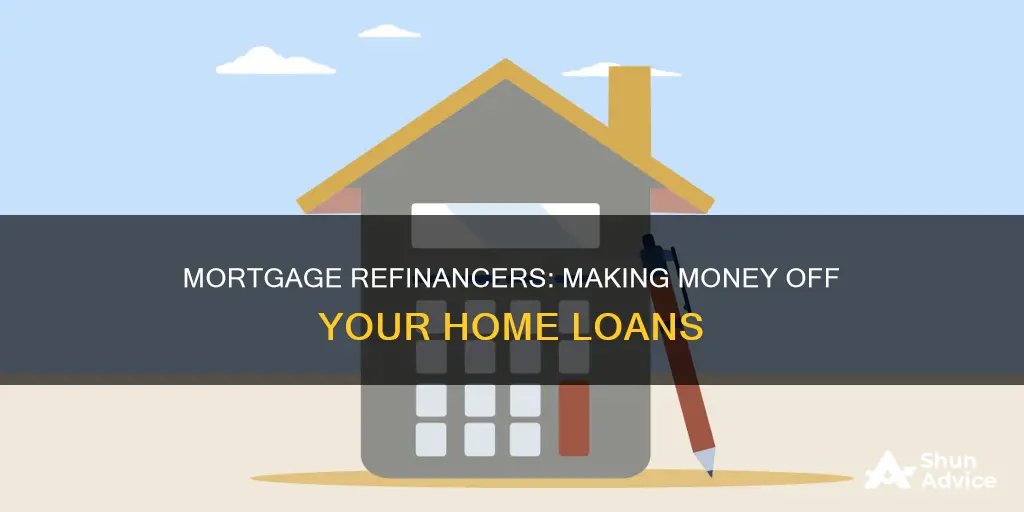
Mortgage refinancing is a strategy used by lenders and borrowers to replace an existing mortgage with a new one, often to take advantage of lower interest rates or improve loan terms. There are several types of refinancing, including cash-in refinance, cash-out refinance, and no-closing-cost refinance. Refinancing can help borrowers lower their monthly payments, reduce their interest rates, or access cash by leveraging their home equity. Lenders, on the other hand, make money through various fees associated with refinancing, such as closing costs, origination fees, and mortgage-backed securities. They can also benefit from the interest paid over the life of the loan. Understanding how mortgage refinancers make money is essential for homebuyers to make informed decisions and potentially save money on their mortgages.
| Characteristics | Values |
|---|---|
| Refinancing type | Cash-out refinance, cash-in refinance, no-closing-cost refinance, short refinance |
| Refinancing purpose | To obtain more favorable loan terms, such as a lower interest rate, lower monthly payments, or a shorter loan term |
| Lender's income sources | Discount points, closing costs, origination fees, mortgage-backed securities |
| Mortgage-backed securities | Lenders group loans of varying profit levels into mortgage-backed securities and sell them for a profit, freeing up capital to make additional loans |
What You'll Learn
- Lenders make money from closing costs, origination fees, and mortgage-backed securities
- A cash-out refinance lets you withdraw cash by using your home equity
- A cash-in refinance lets you pay a lump sum to reduce your loan-to-value ratio
- A no-closing-cost refinance lets you refinance without paying closing costs upfront
- Refinancing can lower your credit score temporarily

Lenders make money from closing costs, origination fees, and mortgage-backed securities
Mortgage refinancers make money through various means, including closing costs, origination fees, and mortgage-backed securities.
Closing costs are fees charged by lenders when a borrower takes out a new loan or refinances an existing one. These costs typically range from 2% to 5% of the loan amount and can include items such as origination fees, appraisal fees, and title insurance. While some borrowers choose to pay these costs upfront, others opt for a no-closing-cost refinance, where the expenses are rolled into the loan, resulting in a higher monthly payment and interest rate.
Origination fees are charged by lenders for processing and underwriting a loan application. These fees can vary depending on the lender and the loan amount and are typically expressed as a percentage of the loan value. Origination fees cover the lender's administrative costs, such as processing the loan application, evaluating the borrower's creditworthiness, and preparing the loan documents.
Mortgage-backed securities (MBS) are another source of income for lenders. After closing a mortgage, lenders group loans with different profit levels into MBS and sell them to institutional investors, such as pension funds and insurance companies. This practice allows lenders to free up capital for additional lending activities and generate revenue by servicing the loans in the MBS they sell. By selling MBS, lenders can also transfer the risk associated with the individual mortgages to the purchasers, providing them with a more secure income stream.
In addition to the above-mentioned sources of income, lenders also benefit from the interest charged on the loans they provide. When a borrower refinances their mortgage, they often aim to secure a lower interest rate, which reduces their monthly payments and the overall cost of the loan. However, the lender still earns money from the interest charged on the new loan, and in some cases, they may be able to offer additional services or products to the borrower, generating further revenue.
Re-amortizing Your Mortgage: A Guide to Refinancing Your Home Loan
You may want to see also

A cash-out refinance lets you withdraw cash by using your home equity
A cash-out refinance is a viable option if you need a large sum of cash. It allows you to use your home equity to withdraw cash, which you can then use for various purposes, such as funding home improvement projects, paying for medical or educational expenses, consolidating debt, or building an emergency fund.
Here's how it works: when you opt for a cash-out refinance, you essentially replace your current mortgage with a new, larger loan. The new loan amount is based on the equity you've built up in your home. For example, if your home is valued at $300,000 and you still owe $100,000 on your mortgage, you have $200,000 in home equity. Lenders typically allow you to borrow up to 80% of your home equity, so in this case, you could potentially withdraw up to $160,000 ($200,000 x 0.80).
The funds from the new loan are used to pay off your existing mortgage, including any closing costs and prepaid items, such as real estate taxes or homeowners' insurance. Any remaining funds after paying off the previous mortgage are then given to you as a lump sum. It's important to note that a cash-out refinance increases your loan balance and monthly payments since you're accessing the cash from your home equity.
Before choosing a cash-out refinance, it's crucial to carefully consider your financial situation and ability to repay the larger loan. Additionally, you should also explore alternative options, such as a home equity line of credit (HELOC), which typically has lower closing costs and provides more flexibility in how you borrow against your home equity.
Removing Someone from Your Mortgage: A Step-by-Step Guide
You may want to see also

A cash-in refinance lets you pay a lump sum to reduce your loan-to-value ratio
A cash-in refinance is a form of refinancing where a homeowner makes a lump-sum payment on their home loan. This lump sum is comparable to the down payment made on the original mortgage. By making this payment, the borrower replaces their current mortgage with a new loan that has a smaller principal balance. This is done to reduce the loan-to-value (LTV) ratio, which is the percentage of the loan balance to the market value of the home. A lower LTV indicates less risk for the lender, which often results in a lower interest rate for the borrower.
The process of applying for a refinance loan is similar to that of obtaining the original mortgage. The lender will require a credit check, and while the minimum FICO® Score is typically 620, many lenders prefer higher scores, and the best rates are usually reserved for borrowers with scores of 760 or higher. The cash-in refinance allows borrowers to put more equity into their homes, thereby lowering their mortgage balance and, in turn, their monthly payments.
A cash-in refinance can be particularly beneficial for borrowers with an adjustable-rate mortgage (ARM) who want to switch to a lower fixed-rate mortgage. It can also help borrowers remove private mortgage insurance (PMI) premiums from their monthly payments, as well as reduce overall borrowing costs. Additionally, it can lower the number of payments required to pay off the loan in full, for example, by switching from a 30-year mortgage to a 15-year mortgage.
However, it's important to consider the potential drawbacks of a cash-in refinance. One disadvantage is that if the original mortgage was obtained during a period of low-interest rates, refinancing to a new loan during a period of higher interest rates could result in higher overall costs. Additionally, there may be additional fees associated with taking out a new loan, including application fees, origination fees, and appraisal fees. Therefore, it's crucial to carefully evaluate one's financial situation and consider seeking expert advice before deciding whether a cash-in refinance is the right choice.
Zero-Down Mortgages: How to Sign Up and Get Started
You may want to see also

A no-closing-cost refinance lets you refinance without paying closing costs upfront
A no-closing-cost refinance is a type of low-cost refinance that allows borrowers to refinance without paying closing costs upfront. Closing costs are the upfront costs, in addition to your down payment, that come with buying or refinancing a home. They are paid once you receive your title or once the transaction is finalized. Closing costs cover things like title searches, taxes, credit report changes, home appraisals, and other loan origination items.
With a no-closing-cost refinance, the borrower finances the closing costs — with interest — as part of their new loan, or takes a higher interest rate. This means that the closing costs are rolled into the loan, resulting in a higher monthly payment and likely a higher interest rate. Alternatively, the borrower can opt for an increased interest rate without a higher loan balance. This option may not be available with all lenders.
A no-closing-cost refinance can be a good option if the borrower is unable to pay the closing costs upfront. However, it is important to consider the long-term costs, as the borrower may end up paying more in interest over time than if they had paid the closing costs upfront. It is also important to consider how long the borrower plans to stay in the home, as a higher interest rate will result in higher monthly payments.
Before deciding on a no-closing-cost refinance, it is recommended to compare rates from multiple lenders, as refinance rates can vary significantly. It is also important to weigh the pros and cons of each option and to be financially prepared for the outcome. Consulting with a home lending advisor can help borrowers make an informed decision about whether a no-closing-cost refinance is the right choice for their financial situation and goals.
Recording a Mortgage in QuickBooks: A Step-by-Step Guide
You may want to see also

Refinancing can lower your credit score temporarily
Refinancing can lower your credit score in several ways, but only temporarily. When you apply to refinance a loan, lenders will perform a hard inquiry on your credit report, which can cause your credit score to dip slightly. This is because you are taking on a new loan, and your ability to repay it has not yet been proven. However, as long as you make your payments on time, your credit score should recover within a few months and may even improve as you demonstrate your ability to handle the new loan.
Another way refinancing can affect your credit score is by increasing your debt. This is especially true for cash-out refinances, where you withdraw equity from your home as a cash payment, resulting in a higher loan balance and increased monthly payments. This can negatively impact your credit utilization ratio, which makes up 30% of your credit score. Your credit utilization ratio measures your debt relative to your credit limits. Ideally, a credit utilization ratio of 30% or less is recommended.
Additionally, refinancing can lead to multiple credit inquiries, especially if you shop around for the best loan terms by applying to several different lenders. Each of these inquiries can negatively impact your credit score. However, you can minimize this effect by limiting your applications to a short period, typically within a 14- to 45-day window. Most credit scoring models treat inquiries within this timeframe as a single inquiry, reducing the impact on your credit score.
It is important to carefully weigh the benefits versus the costs of refinancing, as the money saved through lower interest rates and reduced monthly payments can often outweigh the temporary negative effects on your credit score. By monitoring your credit report before, during, and after the refinance process, you can make more informed decisions and ensure that refinancing aligns with your financial goals.
Mortgage-Backed Securities: Investors' Strategies for Profits
You may want to see also
Frequently asked questions
Mortgage refinancers make money from closing costs, origination fees, mortgage-backed securities, and more. After closing on different types of mortgages, lenders group loans of varying profit levels into mortgage-backed securities and sell them for a profit. This frees up money for the lenders to extend additional mortgages and earn more income.
Refinancing a mortgage means replacing an existing mortgage with a new one. Borrowers often refinance to change the terms of their original mortgage, such as the interest rate, amount borrowed, and length of the loan.
Refinancing can help borrowers take advantage of lower interest rates and improve the loan terms, such as the monthly payment or length of the loan. It can also help them save money in the long term by adjusting their loan term, getting a better interest rate, and changing their loan type.







